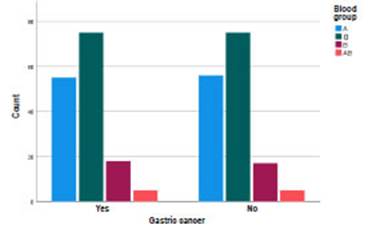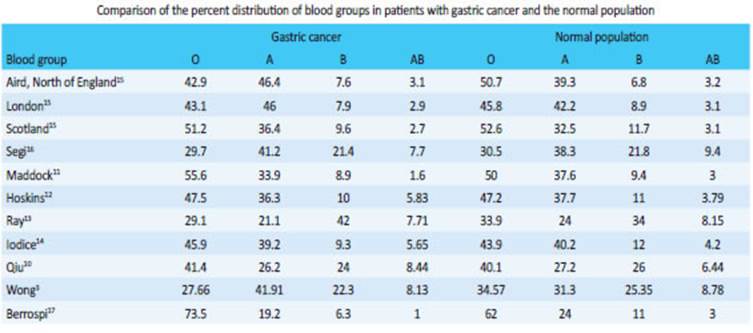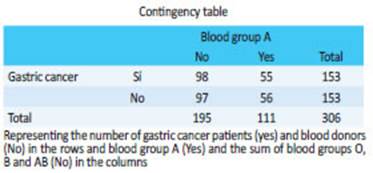Servicios Personalizados
Revista
Articulo
Indicadores
-
 Citado por SciELO
Citado por SciELO
Links relacionados
-
 Similares en
SciELO
Similares en
SciELO
Compartir
Revista argentina de cirugía
versión impresa ISSN 2250-639Xversión On-line ISSN 2250-639X
Rev. argent. cir. vol.114 no.2 Cap. Fed. jun. 2022
http://dx.doi.org/10.25132/raac.v114.n2.1668
Articles
Comparison of the prevalence of blood group A in gastric cancer patients and blood donors
1 Clínica Quirúrgica 3. Facultad de Medicina. Universidad de la República Hospital Maciel. Montevideo. Uruguay.
Introduction
In Uruguay, gastric cancer is the sixth most common cancer in men with an incidence of 13.16 cases per 100,000 inhabitants, as opposed to what occurs in women, in whom gastric cancer is not among the ten most common cancers according to the report of the national cancer registry for the period 2011-20151.
However, when considering mortality, it is the fourth leading cause of death in men and the sixth in women, with a rate of 10.96 and 4.71 per 100,000 inhabitants, respectively1.
Blood group A has been mentioned among the multiple risk factors for the development of gastric cancer2-9. However, this association10 and its higher prevalence compared with healthy subjects11-14 have been questioned by some authors (Table 1).
To establish the situation in Uruguay, we decided to compare the percentage of blood group A in patients with gastric cancer and in blood donors.
The aim of this study is to determine if the percentage of blood group A in patients with gastric cancer is higher than that of the blood donor population of Hospital Maciel and Cooperativa Médica de Florida in the period 2004 - 2019.
Material and methods
We conducted an observational and retrospective study.
The percentage of blood group A in patients with diagnosis of gastric cancer was compared with that of the blood donor population from Hospital Maciel and Cooperativa Médica de Florida in the period 2004 - 2019.
All the variables analyzed were qualitative: gastric cancer, blood donor population and blood group of each patient and blood donors.
All the patients with gastric adenocarcinoma with histological confirmation and with determination of blood group were included. Blood donors were healthy users.
All the patients with diagnosis of other malignancies as lymphomas or stromal tumors, and those with benign tumors or gastric adenocarcinoma without determination of the blood group were excluded from the analysis.
The sample size needed to compare two proportions was calculated using unilateral hypothesis test with 95% confidence and 80% power, considering a proportion of blood group A patients with gastric cancer of 46% and a proportion of healthy patients with blood group A of 32%. The other percentages were obtained from the case series by Aird15.
The number calculated was 149 for each group.
Because of the incidence of gastric cancer in Uruguay and the sample size calculated, we decided to include two healthcare centers to reach such value within a shorter period.
The population was made up of all the patients with gastric cancer who fulfilled the inclusion criteria during the mentioned period and blood donors from Hospital Maciel and Cooperativa Médica de Florida.
Patients with diagnosis of gastric cancer were identified after reviewing the discharge summaries from Clínica Quirúrgica 3, Hospital Maciel and the records of the patients hospitalized in Cooperativa Médica de Florida. Data were retrieved from the medical records and pathology reports.
Blood groups were obtained from the blood banks of Hospital Maciel and Cooperativa Médica de Florida considering the same number of blood donors and patients with gastric cancer included in each institution.
Data were summarized in absolute frequencies and percentages.
We performed a bivariate analysis using Pearson’s chi-square test; a p value < 0.05 was considered statistically significant. The proportions between blood group A healthy donors and gastric cancer patients were compared and data were presented in a contingency table. For this purpose, the variables were dichotomized in “yes” and “no”. In the case of gastric cancer, “no” represented blood donors.
For the variable blood group A, “no” corresponded to the sum of blood groups O, B and AB of gastric cancer patients and blood donors.
The Cramer V test was used to analyze the strength of association.
All the calculations were performed using IBM SPSS Statistics 28 software package.
Results
A total of 153 patients and blood donors were included in each group and classified according to their blood group (Figure 1) (Table 2).

Figure 1 Distribution of blood groups A, O, B and AB in patients with gastric cancer (Yes) and blood donors (No).
The percentage of blood group A in patients with diagnosis of gastric cancer was lower than in the blood donor population (35.9% vs. 36.6%).
There were 55 patients with gastric cancer and blood group A and 98 with the other blood groups. Fifty-six blood donors had blood group A and there were 97 with the other blood groups (Table 3).
When the chi-square test was used to compare both groups, the value obtained was 0.014 (p = 0.905) (Table 4).
The Cramer V test was not used due to the absence of statistically significant differences with the chi square test.
Discussion
The concept of the association between gastric cancer and blood group A arose in the 1950s, when Aird15, in an attempt to explain the higher prevalence of gastric cancer in the north of England, hypothesized the influence of genetic factors. As the northern population had a different incidence of blood groups, especially O and A compared with the southern population, he proposed that the genetic factors associated with gastric cancer would be reflected in the ABO blood group.
To test this hypothesis, he compared a group of patients with gastric cancer from different regions of England and Scotland with another group without gastric cancer selected from the same hospital where gastric cancer patients were treated, and from the local blood bank.
It is worth mentioning that the criteria used for the diagnosis of gastric cancer was histological confirmation in most of the cases, imaging tests finding in others, intraoperative findings and follow-up.
With a total of 1424 and 1442 gastric cancers with blood group O and A, respectively, and 1581 and 1269 controls with blood groups O and A, respectively, he established a higher percentage of blood group A in patients with gastric cancer compared with the control population with a statistically significant difference using the chi-square test and the Yates correction (Table 1).
However, he was clear in his conclusion that, despite the results, one cannot assume a causal relationship between blood group A and gastric cancer.
Similar results were reported by Segi16 in the Japanese population (Table 1).
Similar to our findings that in the population of Uruguay there is no statistically significant difference between the healthy population and those with gastric cancer, Berrospi17 found that among 831 cases of gastric cancer, the percentage of patients with blood group A was lower (19.2%) than in the normal population, which was 24% (Table 1).
These discrepancies have led to the hypothesis that the higher percentage of blood group A in gastric cancers was linked to tumor topography.
Of 584 patients with gastric cancer, White18 determined that blood group A was more common in men in the pylorus and gastric antrum, with a statistically significant difference (x2 = 4.65; p < 0.05), but not in women. The studies by Jennings19 and Billington20 supported this conclusion, as opposed to the publication by Haddock21.
In fact, blood group A predominates in lesions of the antrum and blood group O in the body, regardless of the etiology. In consequence, as gastric cancer is more common in the gastric antrum, it was associated with blood group A, while blood group 0 was associated with gastric ulcers, which occur in the gastric body. However, Doll22 analyzed 857 gastric cancers and 607 peptic ulcers and found no statistically significant differences.
Of note, there is contradictory evidence regarding the higher percentage of blood group A in subjects with a diagnosis of gastric cancer.
Acknowledgments:
To Dr. Federico Verga and Sociologist Jorge Menéndez for their support in statistics. To Mrs. Rita Rodríguez and Mrs. Estela Pérez for the contribution with the blood group results.
REFERENCES
1. Cáncer en Uruguay. Principales tipos de cáncer. Registro Nacional de Cáncer. Comisión Honoraria de Lucha Contra el Cáncer. [Internet]. [Citado 14 de agosto de 2019]. Disponible en: Disponible en: http://www.comisioncancer.org.uy/categoria_53_1.html . [ Links ]
2. Vasan SK, Hwang J, Rostgaard K, Nyrén O, Ullum H, Pedersen OBV, et al. ABO blood group and risk of cancer: A register-based cohort study of 1.6 million blood donors. Cancer Epidemiol. 2016;44:40-3. [ Links ]
3. Wang Z, Liu L, Ji J, Zhang J, Yan M, Zhang J, et al. ABO blood group system and gastric cancer: a case-control study and meta-analysis. Int J Mol Sci. 2012;13(10):13308-21. [ Links ]
4. Zhang BL, He N, Huang YB, Song FJ, Chen KX. ABO blood groups and risk of cancer: a systematic review and meta-analysis. Asian Pac J Cancer Prev. 2014;15(11):4643-50. [ Links ]
5. Piñol Jiménez F, Paniagua Estévez M. Cáncer gástrico: factores de riesgo. Rev Cubana de Oncol. 1998;14(3):171-9. [ Links ]
6. Edgren G, Hjalgrim H, Rostgaard K, Norda R, Wikman A, Melbye M, et al. Risk of gastric cancer and peptic ulcers in relation to ABO blood type: a cohort study. Am J Epidemiol. 2010;172(11):1280-5. [ Links ]
7. Mao Y, Yang W, Qi Q, Yu F, Wang T, Zhang H, et al. Blood groups A and AB are associated with increased gastric cancer risk: evidence from a large genetic study and systematic review. BMC Cancer. 2019;19(1):164. [ Links ]
8. Trostchansky J, Vázquez A. Tratamiento del cáncer de estómago. Lucha contra el cáncer 1996;1(1):23-34. [ Links ]
9. Bermúdez C, Insuasty J, Gamarra G. Grupo sanguíneo A y riesgo de cáncer gástrico en el Hospital Universitario de Santander (Bucaramanga, Colombia). Acta Med Colomb. 2006;31(4):400-10. [ Links ]
10. Qiu MZ, Zhang DS, Ruan DY, Luo HY, Wang ZQ, Zhou ZW, et al. A relationship between ABO blood groups and clinicopathologic characteristics of patients with gastric adenocarcinoma in China. Med Oncol. 2011;28:268-73. [ Links ]
11. Maddock CR. Environment and heredity factors in carcinoma of the stomach. Br J Cancer 1966;20(4):660-9. [ Links ]
12. Hoskins LC, Loux HA, Britten A, Zamcheck N. Distribution of ABO blood groups in patients with pernicious anemia, gastric carcinoma and gastric carcinoma associated with pernicious anemia. N Engl J Med 1965;273(12):633-7. [ Links ]
13. RaY AK. Blood Groups and Cancer in India. Curr Anthropol. 1980;21:794-5. [ Links ]
14. Iodice S, Maisonneuve P, Botteri E, Sandri MT, Lowenfels AB. ABO blood group and cancer. Eur J Cancer. 2010;46:3345-50. [ Links ]
15. Aird I, Bentall HH, Roberts JA. A relationship between cancer of stomach and the ABO blood groups. Br Med J. 1953;1(4814):799- 801. [ Links ]
16. Segi M, Fujisaku S, Kurihara M, Moniwa H. Stomach cancer and ABO blood groups. Tohoku J Exp Med. 1957;66(1):42. [ Links ]
17. Berrospi Espinoza F, Ruiz Figueroa EF, Morante Deza C, Montalbetti Catanzaro JA. Relación entre cáncer gástrico y grupo sanguíneo AB0. Acta Cancerol. 1994;24(3):23-6. [ Links ]
18. White C, Eisenberg H. ABO Blood Groups and Cancer of the Stomach. Yale J Biol Med. 1959;32(1):58-61. [ Links ]
19. Jennings D, Balme RH, Richardson JE. Carcinoma of stomach in relation to ABO blood groups. Lancet. 1956;2:11. [ Links ]
20. Billington BP. Gastric cancer relationship between ABO blood groups, site epidemiology. Cancer. 1956;2:859. [ Links ]
21. Haddock DR, McConnell RB. Carcinoma of stomach and ABO blood-groups. Lancet. 1956;2:146-7. [ Links ]
22. Doll R, Swynnerton BF, Newell AC. Observations on Blood Group Distribution in Peptic Ulcer and Gastric Cancer. Gut. 1960;1(1):315. [ Links ]
Received: October 07, 2021; Accepted: March 09, 2022











 texto en
texto en 






